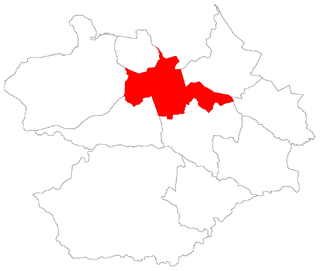
Angra do Heroísmo, or simply Angra, is a city and municipality on Terceira Island, Portugal, and one of the three capital cities of the Azores. Founded in 1478, Angra was historically the most important city in the Azores, as seat of the Bishop of the Azores, government entities, and having previously served as the capital city of Portugal during the Liberal Wars. The population in 2011 was 35,402, in an area of 239.00 km2. It was classified as a World Heritage site by UNESCO in 1983.

The Dutch–Portuguese War was a global armed conflict involving Dutch forces, in the form of the Dutch East India Company, the Dutch West India Company, and their allies, against the Iberian Union, and after 1640, the Portuguese Empire. Beginning in 1598, the conflict primarily involved the Dutch companies and fleet invading Portuguese colonies in the Americas, Africa, and the East Indies. The war can be thought of as an extension of the Eighty Years' War being fought in Europe at the time between Spain and the Netherlands, as Portugal was in a dynastic union with Spain after the War of the Portuguese Succession, for most of the conflict. However, the conflict had little to do with the war in Europe and served mainly as a way for the Dutch to gain an overseas empire and control trade at the cost of the Portuguese.

The naval Battle of Vila Franca do Campo, also known as Battle of Ponta Delgada and Naval Battle of Terceira Island, took place on 26 July 1582, off the coast of the island of São Miguel in the Portuguese archipelago of the Azores, during the War of the Portuguese Succession. A combined corsair expedition, mainly French, sailed against a Spanish naval force made up of Portuguese and Castilian ships, to preserve control of the Azores under the pretender António, Prior of Crato and to defend the islands from incorporation into the Iberian Union, the largest French force sent overseas before the age of Louis XIV.

The action of 30 September 1639 was a naval battle near Mormugão, just south of Goa, India, when a squadron of 9 Dutch ships captured and destroyed 3 Portuguese galleons.

The Fortress of São João Baptista, also known as the Fort of São Filipe or Fort of Monte Brasil is a historic fortress and defensive emplacement, located in the civil parish of Sé, municipality of Angra do Heroísmo in the Portuguese island of Terceira, archipelago of the Azores.

São João Baptista, nicknamed Botafogo ("Spitfire"), was a Portuguese galleon built in the 16th century, around 1530, considered one of the biggest and most powerful Portuguese warships.

The Battle of 4 May was fought in open sea near Salvador, Bahia, on 4 May 1823, between the Imperial Brazilian Navy, under the command of British admiral Thomas Cochrane, and the Portuguese Navy during the Brazilian War of Independence.

The naval Battle of the Abrolhos took place on 12 September 1631 off the coast of Pernambuco, Brazil, during the Eighty Years' War. A joint Spanish-Portuguese fleet under admiral Antonio de Oquendo defeated the Dutch after a six-hour naval battle.

The recapture of Bahia was a Spanish–Portuguese military expedition in 1625 to retake the city of Bahia in Brazil from the forces of the Dutch West India Company (WIC).

The Fort of Santo António, also known as the Redoubt of Santo António, is located on the peninsula of Monte Brasil, in the civil parish Sé, in the municipality of Angra do Heroísmo, along the southern coast of Terceira, Portuguese archipelago of the Azores. It is part of the complex of defensive structures of the Fort of São João Baptista, that crossed-fire with the Fort of São Sebastião in the defense of the Bay of Angra.

The action of 12–17 January 1640 was a naval battle between a Dutch fleet and a combined Spanish-Portuguese fleet during the Eighty Years' War. The battle took place on the Brazilian coast off Pernambuco and was an attempt by a fleet consisting of approximately eighty vessels transporting about 5,000 soldiers under the command of Portuguese Admiral Fernando de Mascarenhas to land reinforcements to bolster the Portuguese militia besieging the city of Recife. On 12 January this fleet was intercepted by a Dutch task force of about forty ships commanded by Willem Loos. The ensuing battle lasted with occasional breaks until the evening of 17 January, when the Spanish and Portuguese fleet retreated and sailed away to the north.

The História trágico-marítima is a famous 18th-century collection of narrative accounts of the travails and wrecks of several Portuguese ships, principally carracks (naus) on the India run between 1552 and 1602, and the oft-harrowing stories of their survivors.

Sede ("Seat") is a district of the municipality of Santa Maria, in the Brazilian state of Rio Grande do Sul. It is situated in the north portion of Santa Maria. Downtown Santa Maria is one of its bairros (neighbourhoods).

São Bento, commanded by captain Fernão de Álvares Cabral, the son of Pedro Álvares Cabral, was a Portuguese carrack of 900 tons wrecked in April 1554 near the mouth of the Msikaba River, midway between Port Edward and Port St. Johns on the Transkei coast of South Africa. The ship had left Cochin on 1 February 1554 and was en route to Lisbon with a cargo of spices, coconuts, silks, porcelain, cornelian beads, cotton cloth and other luxury goods. There are no hull remains at the site.

Events in the year 1916 in Brazil.













